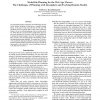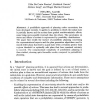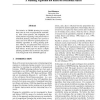FLAIRS
2008
14 years 1 months ago
2008
There are a lot of approaches for solving planning problems. Many of these approaches are based on `brute force` search methods and do not care about structures of plans previousl...
AAAI
2007
14 years 1 months ago
2007
The automated planning community has traditionally focused on the efficient synthesis of plans given a complete domain theory. In the past several years, this line of work met wi...
KR
1994
Springer
14 years 3 months ago
1994
Springer
Despite the long history of classical planning, there has been very little comparative analysis of the performance tradeoffs offered by the multitude of existing planning algorith...
ICCBR
1997
Springer
14 years 3 months ago
1997
Springer
Planning by analogical reasoning is a learning method that consists of the storage, retrieval, and replay of planning episodes. Planning performance improves with the accumulationa...
ICCBR
1997
Springer
14 years 3 months ago
1997
Springer
Realistic and complex planning situations require a mixed-initiative planning framework in which human and automated planners interact to mutually construct a desired plan. Ideally...
ECP
1997
Springer
14 years 3 months ago
1997
Springer
A possibilistic approach of planning under uncertainty has been developed recently. It applies to problems in which the initial state is partially known and the actions have graded...
ECP
1997
Springer
14 years 3 months ago
1997
Springer
In this paper we describe SINERGY, which is a highly parallelizable, linear planning system that is based on the genetic programming paradigm. Rather than reasoning about the world...
AGENTS
1997
Springer
14 years 3 months ago
1997
Springer
We have been developing Rogue, an architecture that integrates high-level planning with a low-level executing robotic agent. Rogue is designed as the oce gofer task planner for X...
KR
1998
Springer
14 years 3 months ago
1998
Springer
The initiative in STRIPS planning has recently been taken by work on propositional satisfiability. Best current planners, like Graphplan, and earlier planners originating in the p...
ICRA
1998
IEEE
14 years 3 months ago
1998
IEEE
Signi cant advances have been made in the area of macro planning for assembly operations i.e., dividing a product into sub-assemblies, determining the sequence of assembly operati...



